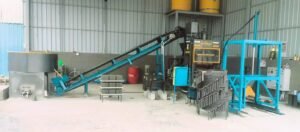Bricks are one of the oldest and most essential building materials in the world, used for constructing structures for thousands of years. In recent times, the demand for high-strength bricks has increased significantly, especially in construction projects that require durable and robust structures. High-strength bricks are designed to withstand the harsh environmental conditions, resist high compressive loads, and provide an extended service life.
The term “high-strength bricks” refers to bricks that have higher compressive strength than standard bricks. Compressive strength is a measure of a material’s ability to resist being compressed or squeezed. Bricks with higher compressive strength can withstand higher loads and stresses without cracking or breaking.
High-strength bricks are made from a blend of carefully selected materials, including clay, shale, and other minerals. These materials are processed to create a homogeneous mixture that is then formed into a brick shape and fired in a kiln. The manufacturing process is critical to ensure that the brick achieves the desired strength and durability.
One of the primary advantages of high-strength bricks is their ability to withstand extreme weather conditions. These bricks can resist heavy rain, strong winds, and temperature fluctuations without losing their strength or integrity. This is particularly important in regions that experience harsh weather conditions, where weaker bricks could crack or break, leading to costly repairs.
Another significant advantage of high-strength bricks is their ability to withstand heavy loads. These bricks are often used in the construction of buildings, bridges, and other structures that must support significant weight. High-strength bricks can resist the pressure exerted by these loads, preventing the structure from collapsing or becoming unstable.
High-strength bricks are also highly resistant to abrasion and wear, making them an ideal choice for high-traffic areas. These bricks can withstand heavy foot traffic without showing signs of wear and tear, making them a popular choice for sidewalks, patios, and other outdoor areas.
In addition to their physical properties, high-strength bricks also offer several environmental benefits. They are made from natural materials, which are renewable and abundant, making them a sustainable choice for construction projects. These bricks are also highly durable, reducing the need for frequent repairs or replacements, which can contribute to reducing waste and resource consumption.
There are various types of high-strength bricks available in the market, each with its unique characteristics and applications. For example, some high-strength bricks are designed specifically for use in fire-resistant applications. These bricks are made from special materials that can withstand high temperatures without breaking down or losing their strength.
Similarly, there are high-strength bricks that are designed for use in highly corrosive environments. These bricks are made from materials that can resist corrosion and prevent the degradation of the brick’s structure over time.
High-strength bricks are a crucial building material in modern construction, offering numerous benefits that traditional bricks cannot provide. They are highly durable, resistant to extreme weather conditions, and can withstand heavy loads, making them an ideal choice for a wide range of applications. As construction projects continue to evolve and demand for stronger and more durable materials increases, high-strength bricks will continue to play an essential role in building construction.




